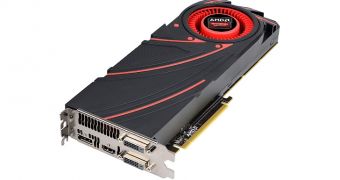Even though neither NVIDIA nor Advanced Micro Devices has any ground-breaking GPU architectures to unveil at this time, new video cards still seem to come out. AMD just revealed the Radeon R9 280.
We already know of the R9 280X, which retails for around $360 / €360 and is pretty strong, even though it still has the R9 290 and R9 290X above it.
We won't even get into the NVIDIA GeForce GTX 780 Ti and Titan Black Edition adapters at this point.
Suffice to say, the R9 280X is a strong high-end board that was supposed to come across as cheaper alternative to the flagship.
Alas, its price still puts it outside the reach of many, so the Sunnyvale, California-based company decided to bring out another.
So, like the R9 290 was made as a tamer R9 290X, the R9 280 has been launched as a cheaper foil to the R9 280X.
And to the NVIDIA GeForce GTX 760, since that is the card that it will have to pull potential buyers away from.
One might even say that the Radeon R9 280 was made specifically so that AMD would have a current-generation board at the $279 / €279 price point.
So what are the specifications, you might ask? First off, the newcomer is based on the 28nm Tahiti graphics processing unit.
This particular iteration of the chip has 1,792 Graphics CoreNext stream processors, 112 TMUs (texture mapping units), 32 ROPs (raster operating units), and a 384-bit wide GDDR5 memory interface. Said interface links to 3 GB of GDDR5 VRAM.
All in all, the board packs a pretty punch for the TDP (thermal design power) of 250W, although this is kind of a disadvantage since it's the same TDP as the stronger R9 280X. Oh well, at least the price difference is significant.
That said, the GPU clocks are of 827 MHz / 933 MHz base/boost, while the VRAM works at 5 GHz. The PowerTune software with boost technology can further push clocks if you like tweaking with such things.
Stay tuned for custom-designed versions of this latest board. Unlike for flagship adapters and new architecture heralds, AMD has not forbidden its partners from changing the frequency or applying their own coolers, or both. We should see quite a few of them, all of them really, unveil one, two, or more R9 280 video boards over the next few days.

 14 DAY TRIAL //
14 DAY TRIAL //